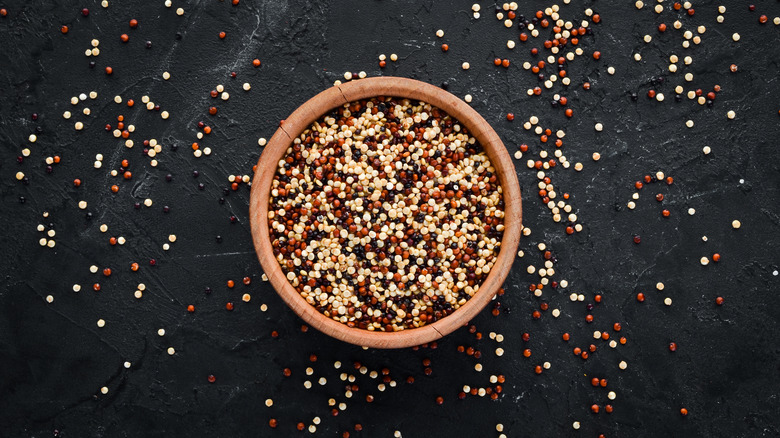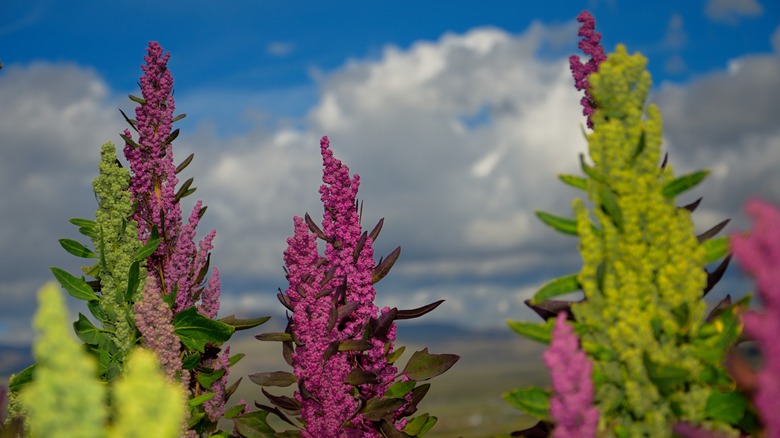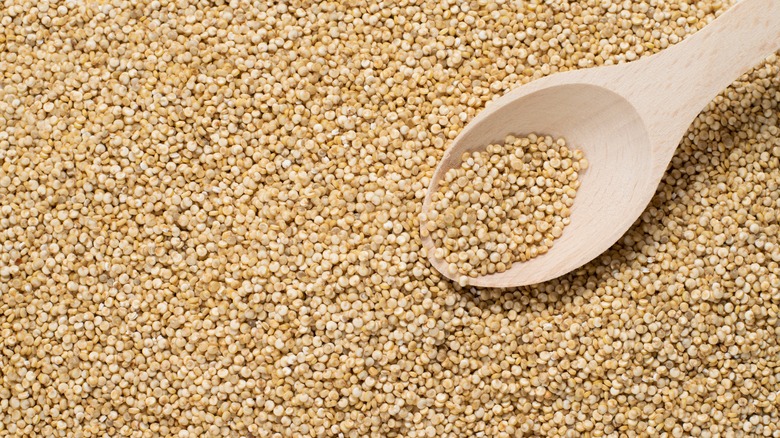Quinoa Is Naturally Resistant To Food Shortages. Here's Why
It's been a decade since the Food and Agriculture Organization of the United Nations declared 2013 the "International Year of Quinoa." Since then, the long-overlooked grain has become one of the trendiest menu items out there, particularly at health-focused spots with a clientele that leans a little, shall we say, "bougie." You might think of quinoa as just another health food trend, but indigenous Americans recognize it as an ancient staple. According to the U.N., pre-Columbian civilizations in the Andes likely domesticated quinoa sometime between 3,000 and 5,000 B.C. Centuries later, in the present day, it's taken on new significance as we fight a growing number of food shortages brought about by climate change, a global pandemic, and various socioeconomic obstacles.
If you know anything about quinoa already, it probably has to do with how healthy it is. The Harvard School of Public Health highlights a number of benefits to eating quinoa, noting its value as a gluten-free grain that is rich in both protein and fiber. Unlike many plant-based protein sources, quinoa is considered a "complete protein" because it contains all nine of the essential amino acids our bodies need to survive. Per MedlinePlus, those amino acids are histidine, isoleucine, leucine, lysine, methionine, phenylalanine, threonine, tryptophan, and valine, and it's extremely rare to find them all in one food. This fact alone is enough to make quinoa an enticing addition to your diet, but it's the grain's resistance to food shortages that's thrilling chefs and scientists alike.
Quinoa can grow in tough climates
The world is facing a food shortage crisis with growing demand being met by a dwindling supply. The Journal of Experimental Botany points out that the global population is expected to surpass 10 billion in 2050, creating unprecedented needs for staple crops and livestock. However, the effects of climate change, including more extreme temperatures, drought, flooding, and soil salinization, have severely reduced crop yields. If we hope to provide enough food for our society, we need to find crops that can withstand harsh environmental conditions, and this is where quinoa comes into play. Being native to the Andes mountains, which are known for their extreme climate, quinoa is naturally resilient to environmental conditions that most other plants could not survive.
In 2017, a team of researchers decoded the genome of quinoa, making key observations about its nutrient profile and growing conditions. According to The Guardian, the researchers noted that quinoa can successfully grow in poor and even over-salinated soil, making use of land that has long been dismissed by agriculture. It can also thrive at incredibly high altitudes, up to 13,000 feet above sea level, and withstand high temperatures in the range of 38 degrees Celsius (that's about 100 degrees Fahrenheit, per Metric Conversions). Quinoa also yields substantially more protein per grain than wheat. The germ (where protein is found) makes up 60% of a quinoa grain versus just 3% of a wheat kernel (via Oldways Whole Grains Council).
Quinoa isn't perfect
Despite its resilient nature, quinoa has one big drawback in the face of climate change. It requires a lot of water, not for growing, but for processing. Quinoa contains compounds called saponins, which, according to The Guardian, are extremely bitter. Saponins prevent birds and other pests from eating the quinoa plant, but they also make it unpalatable for humans unless something is done to eliminate them. Removing saponins from quinoa is time-consuming, costly, laborious, and water-intensive. According to Food Science and Nutrition, saponins are typically extracted by soaking, boiling, or steaming. The Guardian also points out that, while quinoa is resistant to many environmental challenges, it is vulnerable to strong wind and heavy rain, either of which can break the plant's long stalks.
There is hope for eliminating these drawbacks. One of the main reasons that researchers wanted to decode the quinoa genome was to investigate its potential for genetic modifications. The science journal Nature notes that "quinoa is still an underutilized crop, with relatively few active breeding programs," and further efforts in that direction could yield significant advancements. For example, researchers have identified a gene they believe to be responsible for regulating saponin content. But perhaps the most important key to quinoa's viability as a future food staple will be planting more and more of the stuff. At present, it is still a niche product, but The Guardian reports that prices have increased steeply in recent years due to its trendy nature.


